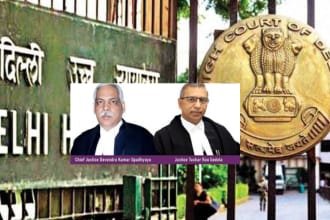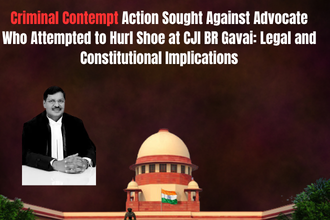In a significant development that could reshape the future of legal education access in India, the Delhi High Court on May 1, 2025, emphasized the need to ensure that language barriers do not exclude any student from appearing in the Common Law Admission Test (CLAT). The Court was hearing a plea filed by Sudhanshu Pathak, who sought a direction to conduct CLAT in regional languages in addition to English.
The petition, filed against the Consortium of National Law Universities (NLUs), was heard by a Bench comprising Chief Justice Devendra Kumar Upadhyaya and Justice Tushar Rao Gedela. The Court directed the Consortium to take a concrete decision within eight weeks, noting that no exclusion should occur due to language barriers for students aspiring to study at NLUs across India.
Current Status of CLAT and Language Disparity
CLAT, the gateway to undergraduate and postgraduate law programs in NLUs, is currently conducted only in English. This has long been a matter of concern for students from non-English medium schools, particularly in rural and semi-urban regions. The medium of the exam arguably puts them at a disadvantage, reducing diversity in NLU classrooms and impacting equal access to premier legal education.
The petitioner’s counsel highlighted that students more proficient in Hindi or other regional languages struggle with the English-only format of the exam.
“By the time a Hindi medium student understands the question, the time is over,” the counsel argued before the Court.
Delhi High Court’s Observations: Inclusion Over Exclusion
Chief Justice DK Upadhyaya acknowledged the complexity of implementing CLAT in multiple languages but underlined that the objective should be inclusivity.
“Nobody can deny the need for exams in local languages. How to get it done—that is the issue,” he noted.
Justice Gedela also echoed the sentiment that while courts aren’t forums for policy debates, the *language of the exam should not become a roadblock for aspiring lawyers.
“English is only a language. In this Court, there are practicing advocates and judges who come from all language backgrounds,” he remarked.
The Bench, while refraining from judicial overreach in a matter involving policy decisions, stressed the moral and social need for making legal education more inclusive.
Consortium’s Past Stance and Future Commitments
In previous hearings, the NLU Consortium maintained that it would not be feasible to conduct CLAT 2024 in regional languages, citing logistical and standardization challenges. However, it also informed the Court that an expert committee had been formed to explore the possibility of holding future CLAT exams in vernacular languages.
Now, the Delhi High Court has given the Consortium eight weeks to take a final decision on the matter, guided by the recommendations of the Advisory Board and past judicial observations.
“We expect that some concrete decision is taken in this matter so that no exclusion on account of any barrier of any language occurs for those who seek admission in NLUs,” the Court stated.
The next hearing has been scheduled for August 20, 2025.
Support from Government and Legal Institutions
The Central Government, represented through its counsel, lent strong support to the petitioner’s cause.
“Why should only English medium students become lawyers and judges?” the government’s lawyer asked. “The door must be kept open.”
This was further endorsed by the Bar Council of India (BCI), which had earlier also supported the petition in 2023. The BCI emphasized the need for linguistic diversity in legal education and practice.
The government’s stance is especially noteworthy, as it was responsible for establishing several NLUs through legislative acts.
The Legal and Constitutional Dimensions
The plea for CLAT in regional languages draws strength from Article 14 (Right to Equality) and Article 21 (Right to Education with dignity) of the Constitution. A uniform English-only format potentially discriminates against students from vernacular backgrounds, raising concerns about equal opportunity in a competitive examination.
Furthermore, under Article 350A, the Constitution of India mandates the provision of instruction in the mother tongue at the primary level, reflecting the importance of language in education.
Precedent: IIT-JEE in Regional Languages
The Bench pointed to how the Indian Institutes of Technology (IITs) adapted to changing times by eventually offering the JEE exam in multiple Indian languages, including Hindi, Marathi, Bengali, and Tamil. This has not only improved accessibility but also diversified the student pool.
“Ten years ago, IIT exams were not held in local languages. Now they are. Ultimately, it is a policy decision,” Chief Justice Upadhyaya observed.
The analogy is apt: if engineering and medical entrance exams can be successfully conducted in regional languages, the legal profession should follow suit, especially in a country where the practice of law is deeply connected with linguistic identity.
Challenges and Road Ahead
While the inclusion of multiple languages is a commendable goal, the implementation will not be easy. The key concerns include:
- Standardization of translation to ensure accuracy and fairness
- Availability of regional language legal resources
- Training of examiners and moderators
- Technological and logistical scaling for multi-language papers
However, these are not insurmountable. With the increasing use of AI translation tools, regional language legal dictionaries, and educational reform initiatives, a multi-lingual CLAT is both possible and necessary.
Voices from the Legal Fraternity
Many legal professionals argue that fluency in English should not be the sole determinant of legal aptitude. Legal reasoning, comprehension, and ethics are language-independent skills.
Senior Advocate Sanjay Poddar, along with advocates Sakshi Raghav and Akash Vajpai, appeared for petitioner Sudhanshu Pathak, strongly advocating for a level playing field for all aspirants regardless of language background.
The move to regional languages could also democratize the legal profession, enabling grassroots voices to enter elite law schools and later the judiciary, litigation, and policy-making spaces.
Conclusion: Towards Inclusive Legal Education
The Delhi High Court’s direction to the NLU Consortium signals a momentous shift toward a more inclusive and equitable legal education framework in India. By urging action within eight weeks and emphasizing the principle of non-exclusion, the Court has recognized the real-world struggles of vernacular medium students.
As India continues to strive for linguistic justice, legal institutions must ensure that language does not become a barrier to legal empowerment. CLAT in regional languages may just be the first step toward a diverse, representative, and accessible legal ecosystem.



